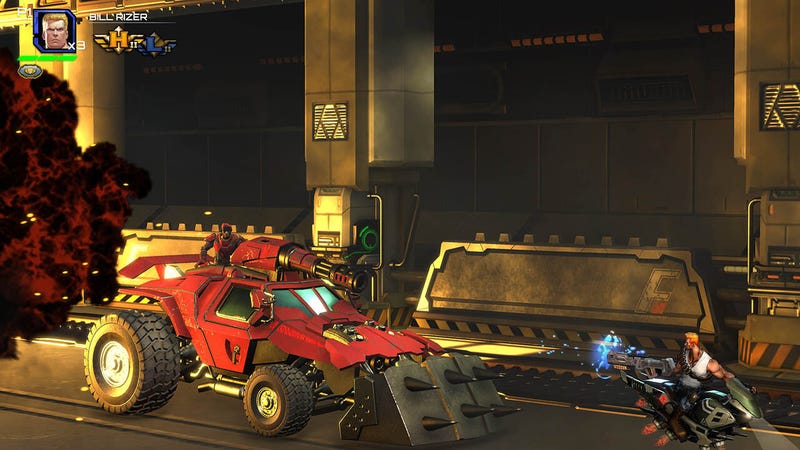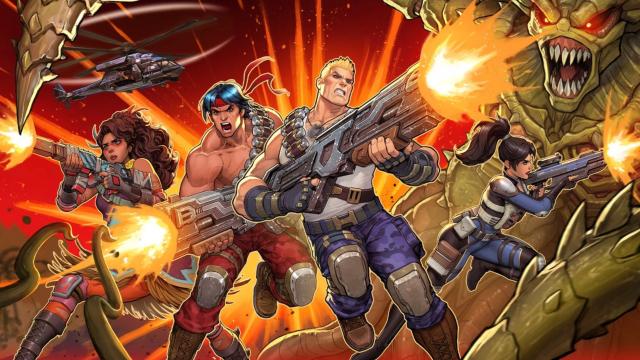If you asked me what I think the best game of the ‘80s is, I’d have a hard time answering. There are just so many hugely important and amazing games of that era, from Ultima IV to Out Run to Super Mario Bros. 3. If, however, you asked me what the most ‘80s game is, I’d answer you right away: Contra. Even before 1987’s Predator hit theaters, Contra hit arcades with its iconic commandos-in-the-jungle action. And though it soon became a cliche for a game’s “ordinary” world to give way to H.R. Giger-inspired horrors, Contra was one of the first and best to do it, seeing you infiltrate the body of a massive xenomorph-like creature in its unforgettable final stage. Even the title, Contra, a strange name for a game ostensibly aimed at children, has an air of military and political scandal that feels emblematic of the decade.
And yet, while the series’ iconography will always remind me of the ‘80s, Contra’s run-and-gun gameplay is timeless. This becomes evident once you’ve spent even a few minutes with the series’ latest entry, Contra: Operation Galuga, which admirably captures the familiar thrill of blasting enemies with a spread gun and the nail-biting tension of facing off against massive biomechanical monstrosities. I recently had the chance to talk to Tomm Hulett, director on the game for development studio WayForward, about navigating the balance between capturing that classic, quintessential Contra feel while also finding ways to update the gameplay for a new era.
He gives me a perfect example of how the team approached this, referring to the age-old tradition of scrolling the original game’s vertical waterfall section so fast that you leave your partner behind, costing them a life. This is still a thing you can do in Operation Galuga–it might seem weird if you couldn’t. “But,” Hulett says, “it’s important to note that while we kept these quintessential Contra moments, we softened the frustration…having your friends leave you behind costs 1 HP, rather than an entire life.”
Yes, while the original Contra (and its immediate sequels) are famously one-hit kill games, Operation Galuga gives you the option to play with HP, suffering a few hits before your character bites the dust. It is, however, just an option, so those who want to tackle the new game the same way they faced the early classics can absolutely do that, too. “This kind of speaks to our overall philosophy where it’s a fully authentic Contra–we didn’t ‘remove’ things that might seem outdated, but we did make them a bit more modern and more fair,” Hulett says. It’s the same old Contra you know and love, but now, if you prefer, you can make it a bit more approachable, which is not the same as making it easy. Famously, the NES game had its own way to do this, too: input the so-called Konami code and play with 30 lives.
Konami was involved with the making of Operation Galuga, as well. As Hulett explains, the company that created Contra understood the challenges inherent in making a new series entry today, maintaining what defines the series while keeping it approachable for newcomers. “Konami absolutely wanted this to be the game that would bring new players to the Contra brand,” he says, “but they also fully agreed with us that it could not be an easy game, or it would disappoint Contra fans. It had to be the most challenging, but also most accessible, Contra ever! The real challenge was trying to thread this needle.”
Part of the way the game does this is via perks, unlockable advantages like mobility boosts, weapon upgrades, and extra lives that you can apply to give yourself a bit of an edge. “This system was loosely inspired by Gradius V, where you’d earn additional lives and continues the longer you played the game,” Hulett explains. “But instead, here, players can choose advantages that seem interesting or useful to them.”

He hopes these new additions to the Contra formula encourage more players to tackle the series’ familiar challenge head-on. “Back in 2007, the sort of mainstream mindset was that buying a game entitled the player to experience its content and ‘challenge’ was artificial and archaic,” he says. “Some well-known games have released since then, and players as a whole are more open to challenging games, where mastery is its own type of reward. This gives me hope that a lot more players might be looking to conquer their first Contra this time around.”
And Operation: Galuga seems like a fine entry point for newcomers looking for their first Contra. In fact, when I saw the game’s reveal trailer, I thought it was a remake of the original game. However, when I played the first few stages, I found that although they had a number of familiar moments and locations from that game, they also departed from it in some major ways. Hulett explains,
In regards to the story, it’s retelling the original Contra. So you’re still going to start in the jungle on Galuga Island. However, we’ve greatly expanded this story and built up the world. Then, from a gameplay standpoint, it’s a brand-new game. Even where the settings are familiar, we didn’t re-create the level layouts or boss patterns. We approached this like the next title in the Contra series. Likewise, we continued to evolve the (classic, 2D) Contra gameplay everyone knows and loves, rather than rewinding to where it started.
And if any studio is going to tackle the tricky task of evolving the classic Contra gameplay, WayForward seems like the one to do it. In 2007, the studio released Contra 4 for the Nintendo DS, the first numbered entry in the series since 1992’s Contra III: The Alien Wars on SNES. Contra 4 was well-received by fans, preserving the great gameplay of previous games in the series but making it more fast-paced and packing it with more explosive setpieces than ever before.
I asked Hulett if, despite being over 15 years ago now, WayForward’s experiences on Contra 4 informed its work on the new game. “There are a lot of people from the Contra 4 days still at WayForward,” he says, “and many of them worked on Operation Galuga as well. For example, besides myself and creative director Matt Bozon (who directed C4), the main level designer returned to do the first pass of many of our stages. Company-wise, I think many people would agree that WayForward ‘leveled up’ when they developed Contra 4, and the game opened a lot of big opportunities with other publishers and other franchises. It would be great if Contra: OG is another such milestone.”

With a new entry in a beloved but long-dormant series, there’s always a danger that it will end up feeling too beholden to what’s come before and play like a “greatest hits” version of the series’ past, appealing to fan nostalgia but doing little to set itself apart. It’s clear that Hulett wanted to avoid falling into that trap with Operation Galuga. “Rather than just redoing those moments,” he says, “I wanted us to reduce them down, and encapsulate what Contra has been to this point in time. My hope is that Contra: OG contains the spirit of all those exciting moments, making it the ultimate expression of the first 35+ years of Contra. Where the series goes from here is unknown, but returning to the start of the story seemed like an appropriate time to celebrate why it’s so fiercely beloved.”
Contra: Operation Galuga is available now on Switch, Xbox, PlayStation, and PC.

Leave a Reply